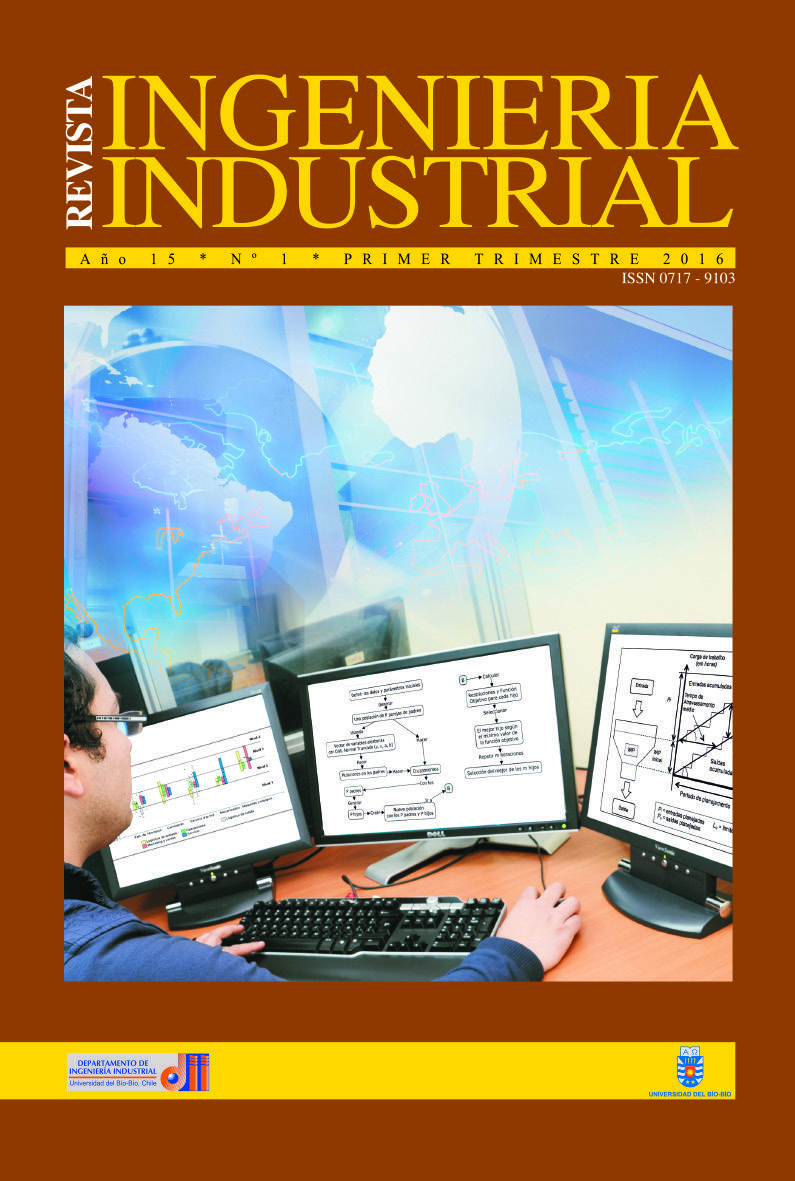Controle pela carga de trabalho de um sistema flexível de manufatura
Palabras clave:
controle de manufatura, inventário, tempo de atravessamento, sistemas flexíveis de manufatura, simulação computacionalResumen
O objetivo deste artigo foi calcular tempos de atravessamento e inventário médios em um sistema de manufatura flexível, que atende muitas ordens, de tamanho e mix variado. Foi aplicado o workload control (controle por carga de trabalho) para o cálculo da situação atual, e simulação computacional (software ProModel) para avaliar duas situação alternativas: aumento na demanda e redução na demanda. O método de pesquisa foi a modelagem quantitativa. Os resultados apontam que atualmente há excesso de inventário, provocado por desequilíbrio entre demanda e entrega da manufatura, o que é típico em sistemas de filas. Seria necessário sincronizar melhor entradas e saídas. Os cenários simulados apontam que a manufatura não suporta aumento de carga, crescendo continuamente o inventário, até a operação tornar-se inviável. Para estabilidade do inventário, seria necessário reduzir a demanda, se for mantido o atual regime de trabalho, com entradas aleatórias e independentes.
Descargas
Citas
ANTUNES, J., ALVAREZ, R., KLIPPEL, M., BORTOLOTTO, P., and PELLEGRIN, I. Sistemas de Produção. Porto Alegre: Bookman, 2007.
BARTEZZAGHI, E., SPINA, G., and VERGANTI, R. Strategically flexible production and the extra-firm infrastructures: How regions become attractive. Integrated Manufacturing Systems, 1997, vol. 8, no. 5-6, p. 333–346.
BECHTE, W. Theory and practice of load-oriented manufacturing control. International Journal of Production Research, 1988, vol. 26, no. 3, p. 375–395.
BERTRAND, J.W.M., and VAN OOIJEN, H.P.G. Customer order lead times for production based on lead time and tardiness costs. International Journal of Production Economics, 2000, vol. 64, no. 1, p. 257–265.
BORCHARDT, M., SELLITTO, M., and PEREIRA, G. Serviços de pós-venda para produtos fabricados em base tecnológica. Produção Online, 2008, vol. 8, no. 2, p. 1-26.
CHANG, H.C., OUYANG, L.Y., WU, K.S., and HO, C.H. Integrated vendor-buyer cooperative inventory models with controllable lead time and ordering cost reduction. European Journal of Operational Research, 2006, vol. 170, no. 2, p. 481–495.
FACCHIN, T., and SELLITTO, M.A. Medição do inventário em processo e tempo de atravessamento em manufatura por modelagem em redes de Petri e diagrama de resultados. Gestão & Produção, 2008, vol. 15, no. 2, p. 307–321.
FERNANDES, N.O., LAND, M.J., and CARMO-SILVA, S. Workload control in unbalanced job shops. International Journal of Production Research, 2014, vol. 52, no.3, p. 679-690.
GLOCK, C. Lead time reduction strategies in a single-vendor–single-buyer integrated inventory model with lot size-dependent lead times and stochastic demand. International Journal of Production Economics, 2012, vol.136, no. 1, p. 37-44.
GROOVER, M. Automação Industrial e Sistemas de Manufatura. São Paulo: Pearson, 2011.
HASKOSE, A., KINGSMAN, B., and WORTHINGTON, D. Modelling flow and jobbing shops as a queueing network for workload control. International Journal of Production Economics, 2002, vol. 78, no. 3, p. 271–285.
HASKOSE, A., KINGSMAN, B., and WORTHINGTON, D. Performance analysis of make-toorder manufacturing systems under different workload control regimes. International Journal of Production Economics, 2004, vol. 90, no. 2, p. 169–186.
HENDRY, L., LAND, M., STEVENSON, M., and GAALMAN, G. Investigating implementation issues for workload control (WLC): A comparative case study analysis. International Journal of Production Economics, 2008, vol. 112, no. 1, p. 452–469.
HENDRY, L., and KINGSMAN, B. Production planning systems and their applicability to make-to-order companies. European Journal of Operational Research, 1989, vol. 40, no. 1, p. 1–15.
HENDRY, L., KINGSMAN, B., and CHEUNG, P. The effect of workload control (WLC) on performance in make-to-order companies. Journal of Operations Management, 1998, vol. 16, no. 1, p. 63–75.
KINGSMAN, B., WORDEN, L., HENDRY, L., MERCER, A., and WILSON, E. Integrating marketing and production planning in make-to-order companies. International Journal of Production Economics, 1993, vol. 30-31, no. C, p. 53–66.
KOUVELIS, P. Design and planning problems in flexible manufacturing systems: a critical review. Journal of Intelligent Manufacturing, 1992, vol. 3, no. 2, p. 75-99.
KUMAR, A., and MOTWANI, J. A methodology for assessing time-based competitive advantage of manufacturing firms, International Journal of Operations and Production Management, 1995, vol. 15, no. 2, p. 36–53.
LAND, M., STEVENSON, M., and THÜRER, M. Integrating load-based order release and priority dispatching. International Journal of Production Research, 2014, vol. 52, no. 4, p. 1059-1073.
MOURA, G., MARTINS, J., LUCKOW, F., and SELLITTO, M. Medição de tempo de atravessamento e inventário em manufatura de equipamentos eletromecânicos. 2007, GEPROS. Gestão da Produção, Operações e Sistemas, vol. 2, no. 4, p. 107-120.
OMAR, M., SARKER, R., and OTHMAN, W. A just-in-time three-level integrated manufacturing system for linearly time-varying demand process. Applied Mathematical Modelling, 2013, vol. 37, no. 3, p. 1275-1281.
PEREIRA, G., SELLITTO, M., BORCHARDT, M., and GEIGER, A. Procurement cost reduction for customized non-critical items in an automotive supply chain: An action research project. Industrial Marketing Management, 2011, vol. 40, no. 1, p. 28-35.
SELLITTO, M.; BORCHARDT, M.; and PEREIRA, G. Avaliação multicriterial de desempenho: um estudo de caso na indústria de transporte coletivo de passageiros. Gestão & Produção, 2006, vol. 13, no. 2, p. 339-352.
SELLITTO, M., BORCHARDT, M., and PEREIRA, G. Medição de tempo de atravessamento e inventário em processo em manufatura controlada por ordens de fabricação. Produção, 2008, vol. 18, no. 3, p. 493-507.
WANG, J., and ZHOU, G. Study on response time decision of supply chain based on instant customerization. Journal of Applied Sciences, 2013, vol. 13, no. 22, p. 5422–5427.
WIENDAHL, H.P., and BREITHAUPT, J.W. Automatic production control applying control theory. International Journal of Production Economics, 2000, vol. 63, no. 1, p. 33–46.
WIENDAHL, H.P., and BREITHAUPT, J.W. Backlog-oriented automatic production control. CIRP Annals - Manufacturing Technology, 2001, vol. 50, no. 1, p. 331–334.
WIENDAHL, H.P. Load-oriented manufacturing control. Berlim: Springer, 1995.
WIENDAHL, H.P., GLÄSSNER, J., and PETERMANN, D. Application of load-oriented manufacturing control in industry. Production Planning & Control, 1992, vol. 3, no. 2, p. 118–129.
Descargas
Publicado
Número
Sección
Licencia
Revista Ingeniería Industrial by Revista Ingeniería Industrial is licensed under a Creative Commons Reconocimiento 4.0 Internacional License. Creado a partir de la obra en revistas.ubiobio.cl/index.php/RI/. Puede hallar permisos más allá de los concedidos con esta licencia en http://revistas.ubiobio.cl/index.php/RI/about/

















